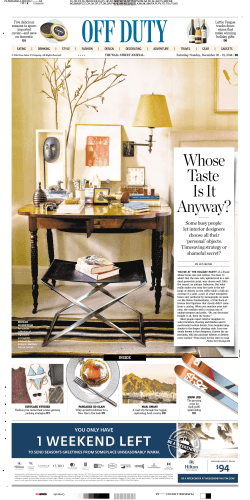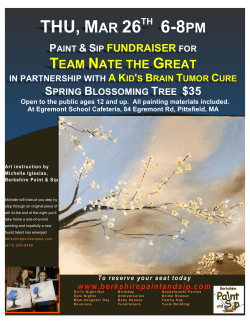
Joyous Abandon
Joyous Abandon
!"#$%!&#'()*#'(+(,-).(-/'012)34)!15"(2%61(10#+"())
73-&0#5&)89/01--'"('-&:;"<"0)='1<2)70+-&)>1<1()=0#($1(&?#<10)
*0"@15&)501#&12)34)7(201A)B11)
)
Helen Frankenthaler
C73-&0#5&)*#'(&10)D?")!?#/12)#)E"F1G1(&H))
)
I"0()'()JKLM)#(2)0#'-12)'()N1A)O"0$);'&4P)
=0#($1(&?#<10Q-)5#0110)-/#((12)-'9)215#21-)R(+<)
?10)21#&?)'()LSJJP)#(2)'-)/0"3#3<4)31-&)$("A()T"0)
/'"(110'(,)&?1)U-"#$%-&#'(U)&15?('VR1)'()/#'(+(,)
A?'5?)A"R<2)315"G1)&?1)'(-/'0#+"()T"0)5"<"0)
W1<2)/#'(+(,X))
)
CHILDHOOD, EDUCATION AND INFLUENCES
• At age 4, filled her bathroom sink with water and
put drops of her mother’s nail polish on the surface of
the water stirring it around to make different designs.
• Her favorite childhood game involved pictures in
which different faces and animals were hidden. The
challenge was to find as many as possible.
• At the Dalton School, she studied with the famous
Mexican muralist Rufino Tamayo. Of that time in her
life, she has said, "It saved me and made me flower at
a fragile time in my life. The war was on, my father
had died and I had not done well in school. It
introduced me to the thrill of being an artist.”
• In college, Frankenthaler studied with renowned
painter Paul Feeley who encouraged her to explore
working in a Cubist manner: reject copying nature
and reject traditional techniques of Realism,
including perspective, modeling and foreshortening.
ABSTRACT EXPRESSIONISM
1950S
Clyfford Still, No. 2 1950
Life magazine cover 1951 “Abstract
Expressionists”
Willem de Kooning,
Ganesvoort Street 1949
Franz Kline)
Mark Rothko)
In the 1950s, Abstract Expressionism was at its
influential peak. Born out of the aftermath of WWII
and the resulting changes in culture, technology, and
attitudes. Television was popular, and almost
everyone owned a car. Rock and Roll took over the
music scene.
Artists of the time wanted to break away from
tradition, both in terms of technique and subject
matter, these artists valued intuition, spontaneity
and most importantly, PROCESS.
Jackson Pollock
Pollock’s paintings had a profound influence on Frankenthaler. This made her
realize the importance of getting her paintings off of the easel and working on
them from above.
Additionally, Pollock’s use of unprimed canvas—leaving it open for paint
absorption—excited her. However, the way he painted didn’t. In fact, she has
said, “It’s a kind of boring accident to me, a drip. There are many accidents that
are very rich that you can use, but if you exploit a drip it’s very boring and
familiar to begin with. Drips are drips.”
NEW PROCESS
”SOAK STAIN”
Process or the act of doing was
THE critical factor for the
Abstract Expressionists.
Frankenthaler stated that
beginning a painting was
“making a start somewhere
and then seeing what happens
through the sustained act of
painting.”
This intuitive and instinctual
method was used not only in
the beginning, but for the
overall composition, color,
space and other formal
elements. Frankenthaler
reacted to what was before her,
trusting herself and embracing
the process.
Mountains and Sea, 1952
Her first soak-stain painting inspired by her visit to Pollock’s studio and a trip to Nova
Scotia (though abstract, many of Frankenthaler’s paintings were developed through her
unconscious memories of actual or imagined landscapes.
“A really good picture looks as if it's happened at once.
It's an immediate image. For my own work, when a
picture looks labored and overworked, and you can
read in it—well, she did this and then she did that, and
then she did that—there is something in it that has not
got to do with beautiful art to me. And I usually throw
these out, though I think very often it takes ten of those
over-labored efforts to produce one really beautiful
wrist motion that is synchronized with your head and
heart, and you have it, and therefore it looks as if it
were born in a minute.”
-Helen Frankenthaler
The Bay, 1963
Helen Frankenthaler
Around The Clock With Red, 1983
Helen Frankenthaler
)
In the next painting, what colors do
you think stand out?
Which colors do you prefer? Why?
)
ORGANIC –!
Refers to shapes or forms
having irregular edges
or to surfaces or objects
resembling things existing
in natureX)
)
Smalls Paradise, 1964
Helen Frankenthaler
A Green Thought in a Green Shade, 1981
Helen Frankenthaler
Do you think
Helen Frankenthaler used paint
without mixing it or did she
mix them to create their own
unique colors? Which do you
like better?
)
Granada, 1953
Helen Frankenthaler
)
Southern Exposure, 2005
Helen Frankenthaler
What techniques do you think
Frankenthaler used to create such a
variety of color?
)
COLOR FIELD:
A style of abstract painting that
de-emphasizes gesture and brushstroke
in favor of form and process.
In Color Field painting "color is freed
from objective context and becomes
the subject in itself.”
Pink Lady, 2005
Helen Frankenthaler
)
Contentment Island, 2004
Helen Frankenthaler
)
Artists often use color to convey
emotion. What are some emotions
and what colors do you associate
with them?
For E. M., 1981
Helen Frankenthaler
)
Helen Frankenthaler in her studio
Quattrocento, 1984
)
BaySide
Helen Frankenthaler
)
THE PROJECT
Frankenthaler quotes on starting a new painting:
“I will sometimes start a painting feeling “What will happen if I work with
three blues and another color, and maybe more or less of the other color than
the combined blues?” And very often midway through the picture I have to
change the basis of the experience.”
“I’d rather risk an ugly surprise than rely on things I know I can do.”
COLLABORATION:
working together for a a common goal
THE BENEFITS OF COLLABORATIVE ART:
• !Students can work on larger pieces together
• !Students can learn techniques from one another
• !Students can get different input/perspectives and insight
into their classmates
• !Students can reduce anxiety towards trying new skills
• !Students learn about cooperation vs. competition
1. Wet canvas with spray bottle
2. Pour diluted paint onto canvas
3. Use spray bottle to spread and blend paint
CONTINUE TO ADD MORE PAINT
Explore the “Soak Stain” process
What happens when you..
• Lift the edges of the canvas
• Spray water on the painted canvas
• Use wooden tool on its side
to spread paint around canvas
Experiment
COLLABORATIVE:
INDIVIDUAL
What To Paint?
This project is about abstract painting,
process and chance not creating literal
or representational images.
For inspiration
look at the sky, clouds, and surfaces of things.
INDIVIDUAL:
Aesthetic Valuing
!
Take time at the end of the project to have students reflect on their artwork by asking
these grade level questions. The conversation can be facilitated by docents or
classroom teachers.
TK-1
What colors did you choose and why? What colors stand out?
2-3"
Did you learn anything that surprised you?
Do the colors in your piece work together(complement) or fight each other (contrast)?
4-5"
Does your art reflect Helen Frankenthaler’s style? How and Why?
If you could ask Helen Frankenthaler 3 questions what would they be?
If time is short, any of the following questions are appropriate for all grade levels:
When you look at your artwork, how does it make you feel?"
Are you happy with your project? What do you like best about your project?
)
)
© Copyright 2025









